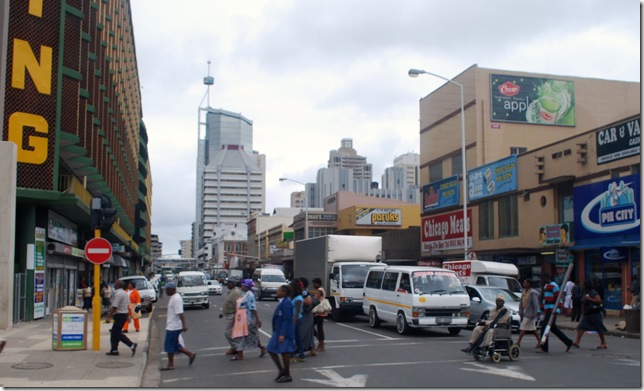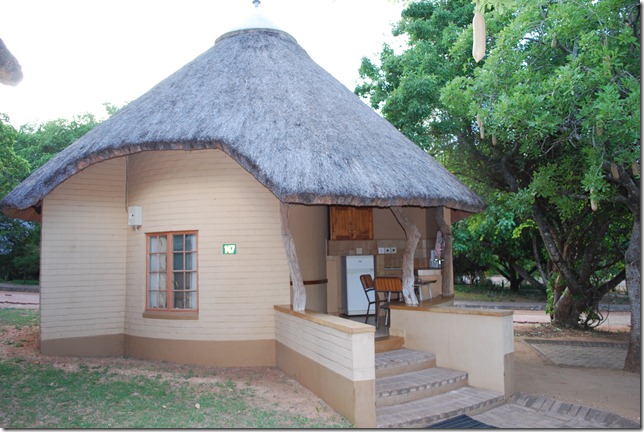The sun rises just before 5am here, and this morning it’s actually visible through clear skies. The last several days have been rainy ones. We weren’t the only boat needing to have some work done and trying to catch the weather window that started Wednesday. Unfortunately, with all the competing work, our canvas and furler bearing replacements weren’t quite done in time and were delivered in the rain, so we’re still here. I got the last of it yesterday and today I’ll be trying to get everything back together so I can catch the next weather window to make the passage along the Wild Coast. Lauren left yesterday for a much deserved trip home for the holidays that has more than a few people pretty excited, so I’ll be single-handing or possibly taking on a local to help with night watches.
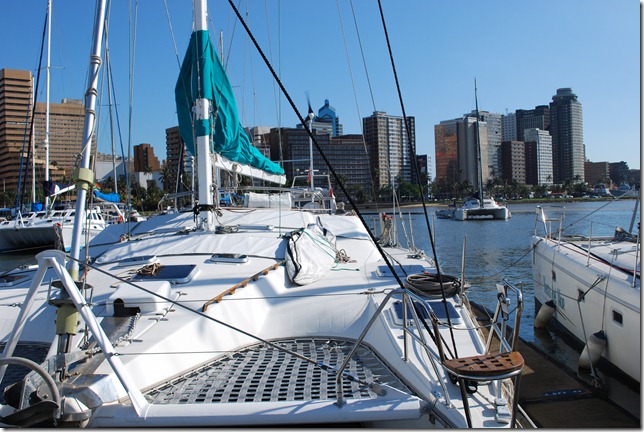 The new gray tramps and white suncovers give her nice new look. The new mainsail cover goes on when we get back.
The new gray tramps and white suncovers give her nice new look. The new mainsail cover goes on when we get back.
The next 700+ miles to Cape Town are the most dangerous of our trip in the wrong weather, but shouldn’t be any problem at all as long as we take advantage of good weather windows and the forecasts hold. I’m hoping to catch up with Marionette or some of our other friends by Christmas, but the weather is the determining factor. Bad storms along the coast regularly create very steep freak waves of 65 feet or more, so you have to have a healthy respect for the conditions and let the itinerary become what it becomes.
We made a couple more friends here that are worth mentioning. Diogo and Flavio are two young Brazilians sailing a 45 foot catamaran around the world. Someone else is paying for their trip, though. All they had to do to earn that sponsorship was windsurf by themselves, with only small backpacks, along the entire coast of Brazil. If I remember right, it took a year and two months. As if that wasn’t enough, Diogo windsurfed from the Brazilian coast to the beautiful offshore island of Fernando de Noronha and back, a distance of 200 nm each way, without a support boat. They had some pretty good stories and the pics and videos from this trip are pretty amazing. Diogo is a dedicated surfer as well and some of his helmet cam surfing videos are mind blowing, especially when he’s surfing through perfect tubes that are curled over clear water so shallow you can see the details of the coral just beneath it the surface. Definitely not for the faint of heart. He joked that when the waves are that perfect and they’re the only boat anchored there in a remote place, his wife tends to get a little upset with him because he surfs for 10 hours and then plops into his bunk exhausted, just wanting to see the video of the waves. Like Diogo said, they probably know the coast of Brazil better than anyone, and they gave us some tips on places to stop in Brazil that sound interesting. You can check out their website at http://www.destinoazul.com.br.
We also had the first tango night aboard Pura Vida. One of Marionette’s crew, Gaya, has been taking tango for 8 or nine months and doing very well, so she gave about four couples a humorous and fun tango lesson. It’s a really interesting experience, especially for couples. I don’t think my not being a dancer made a lot of difference as it’s quite a bit different from other dancing. After learning the very basic approach to timing and the proper way to take a step in any direction, the real challenge becomes communicating nonverbally to your partner which direction you want to take a step in. You stand balancing with your upper bodies leaning into each other so that the follower can sense the direction the lead wants to move by weight changes and motion. Which foot you’re going to move in that direction depends on which foot your weight is on at the moment, with the lead having the job of being aware of and controlling the shifting of weight from foot to foot for both dancers. Lots of entertaining fun, but I’m glad there are only photos (we’ll get them from Marionette and post later) and no video. The concepts are simple, but the execution is anything but.
I’m really enjoying our time in Durban. Between boat projects and errands, there’s plenty to do during the day, and although it’s not safe to leave the marina area at night, we have several friends here at the marina (some old, some new) to keep us company. For example, our friends from S/V Marionette are here. Yes, they managed to hand-steer their way across the Indian Ocean! Markus’ girlfriend, Cathi, returned from her two-month hiatus in Sweden and is being visited by her best friend, so I’ve had opportunities to hang out with other women for the first time in quite a while.
I also had the opportunity to get in a bit of exercise. My afternoon run to the beach was my first foray into the city alone, and my adrenaline was pumping, leading me to run faster than I normally would. Couple that with the fact that it has been months since I’ve had a chance to run, and I think that explains why I’ve been aching ever since! The scene at the beach was a nice reward, though. There were numerous families taking advantage of the summer school holidays, and many of them stood watching a group of teenagers perform traditional Zulu dance near the public pool. The teens stood in a cluster and chanted while one of the older boys played a large drum. One by one, the dancers would emerge from the group and perform in front. The girls kicked their legs up to their ears several times, and at the end of their performance, they threw both legs in front of them and landed on the ground on their rear! Ouch!
As I ran back to the marina, I passed by three older teenage girls walking down the street and observed their suggestive clothing and manner. I couldn’t help but think about the HIV/AIDS epidemic here in South Africa. This country is ranked 5th in the world in terms of prevalence (18%) and is #1 in terms of the number of people with the virus (around 5.7 million!). I’ve seen several murals and posters around Durban about the problem, and I’m sure that teenagers are a group that is highly targeted by prevention programs, but considering that the last president of SA (Mbeki) did not believe that AIDS was sexually transmitted, I can imagine that there are still some myths and misconceptions out there.
The American dollar goes pretty far here, and as usual, we are using that to justify spending more than we normally would. Most of these expenditures could be considered investments, though. (Dallas’ daily “bunny chows” probably don’t count, but they’re very cheap!) We decided to ask Clyde, the sailmaker who is working on our jib and trampolines, to make us a new mainsail cover and sun shades and to sew up the bimini. Pura Vida should be departing Durban looking new and improved.
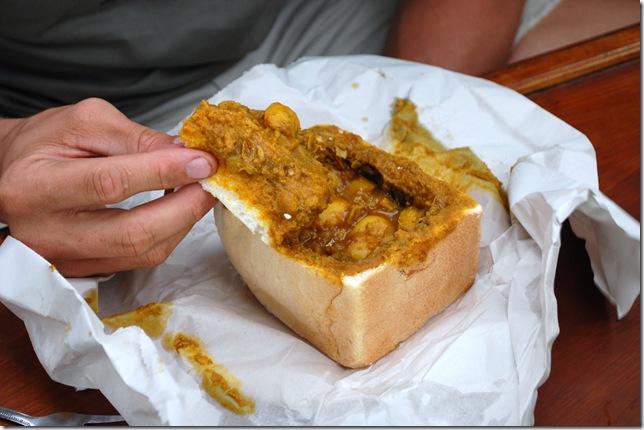 The “bunny chow” – curry inside a hollowed out bread loaf
The “bunny chow” – curry inside a hollowed out bread loaf
Dallas has devoted some of his time each day to boat maintenance and has checked several things off of the list. Two young SA guys who are taking a class to become certified as crew have begun to hang around the boat in the afternoons to learn a thing or two and have even offered to do some work, so we’ll see how that works out.
The SA guys also showed up last night (along with two friends) for an impromptu party aboard Pura Vida. Word of something happening spread like wildfire throughout the marina, and in the end, we had 10 different nationalities represented: American, Chinese, Australian, Swedish, Belgian, Brazilian, French, Chilean, Indian, and of course, South African. Although it was not the first language for most of those who attended, everyone spoke English very well.
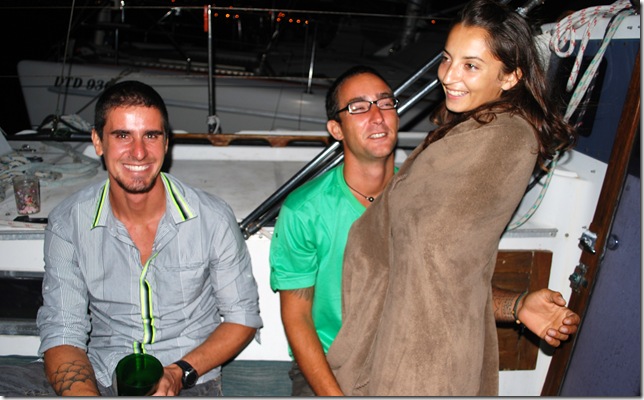 Diogo (Brazil), Markus (Belgium), and Cathi (Chile)
Diogo (Brazil), Markus (Belgium), and Cathi (Chile)
T’is the season for Christmas parties and of course, for shopping. If anyone is interested in purchasing a 2011 Pura Vida calendar for themselves or a loved one for $20, please shoot me an email (lricherson@hotmail.com). Thanks again for your support!
I think I’ll try to save you all the trouble of reading about the details of spotting and observing Africa’s large mammal’s (and birds) in the wild and just summarize by saying that Kruger Park was definitely one of the more memorable stops on our voyage. We can heartily recommend an African game park visit. Brian and Monica have been visiting Kruger for 20 years and our 2 day visit was one of the best they’ve had in terms of the number of different and rare species we saw, including 2 leopards in one morning (they’ve seen 4 or 5 and many people have never seen one), a wild dog pack (there are only about 180 wild dogs left in the park), and the large and rare ground hornbill bird catching bugs and then flying up to its nest in the hollow of a dead tree to feed its mate who was sitting on the eggs. Ground hornbills only fly rarely, are monogamous and generally won’t mate if their first mate dies, and are being pressured by the overpopulation of elephants in Kruger, who are pushing down the trees they use for nesting.
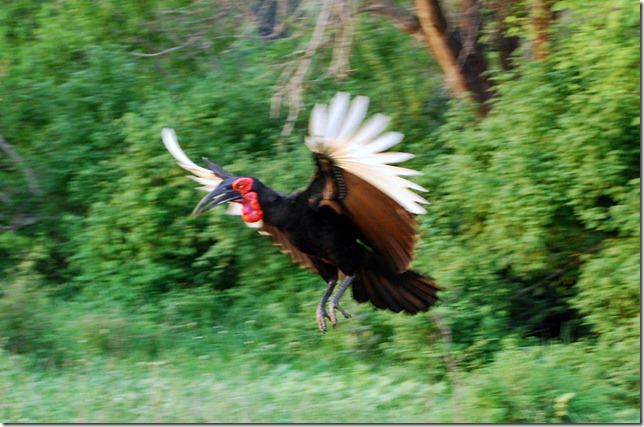 Southern ground hornbill lowers the flaps and landing gear
Southern ground hornbill lowers the flaps and landing gear
There are a number of large camps inside the park with both camping sites and bungalows. The camps are fenced for protection, with gates closing around sunset and opening again with the daylight. We spent both nights in bungalows at Skukuza, one of the larger camps. After breakfast we’d head out for a day of driving slowly along both paved and unpaved roads looking for game or a traffic jam (which means lions or a leopard have been sighted). The bungalows included outdoor kitchenettes and a BBQ, so evenings were spent socializing around a braai.
After saying farewell to Kruger on Sunday afternoon, we drove to a beautiful lodge/bungalow-style hotel called Ya Mati on the banks of a river where Brian had reserved the river cottage. After a dip in the private swimming pool (small, cold and a little dirty, but fun nonetheless) it was time for Braai III, and our skills were definitely improving with a little practice.
In the morning Brian and Monica dropped us off at Moholoholo Rehabilitation Center for a morning tour. The center treats wounded wild animals and does breeding with a few species as well. Animals that can’t be released to the wild or given to a game reserve or zoo are kept on site. Most of the animals were in cages, but it was much more personal than a zoo. We learned about the different species of vultures, each with a neck, head, and beak that is specially adapted to performing a particular part of the “cleaning” of a carcass. For instance, only one species has a beak capable of opening up a carcass, so if the bone-cleaner types show up before them, they just stand around and wait for the sharp-beaked carcass openers to arrive. We had the chance to feed a baby black rhino, and we were able to stand less than a foot from lions growling viciously for their meaty snack It wasn’t a full roar, but from less than a yard away, it was a chilling sound. Only the volcano on Tanna could compare in terms of the raw power of the sound and the way it completely captures your attention, giving you chills even the 2nd and 3rd times you hear it.
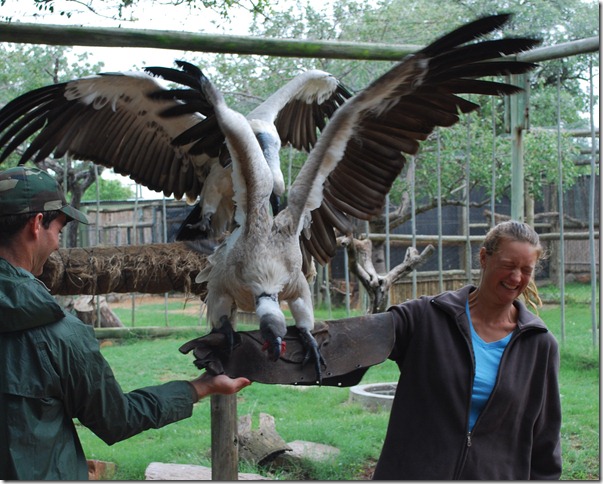 Lauren’s wincing from being brushed by the vulture’s wings as it flew in for the scrap of meat
Lauren’s wincing from being brushed by the vulture’s wings as it flew in for the scrap of meat
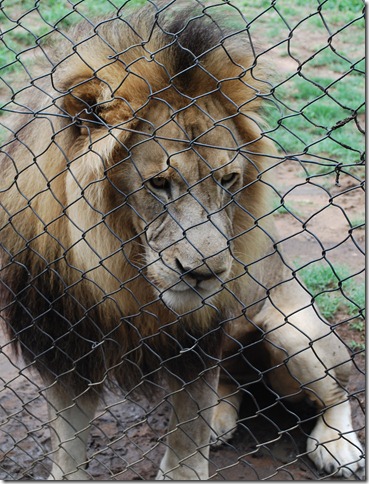 Check out the mangled links for fence in the foreground
Check out the mangled links for fence in the foreground
One of my favorites was the wild dogs. They’re incredibly efficient killers, using their superior endurance to run their prey to exhaustion and then sometimes killing the animal in less than a minute by ripping off pieces of underbelly as it’s running until it succumbs and then bleeds to death. We had a chance to watch them feed on a cow leg that was thrown into their pen, and it’s clear that whoever invented the lion’s den as a form of execution didn’t have access to wild dogs. When hunting (or anticipating a cow leg being thrown over the fence), they start a high-pitched yipping that sounds more like a bird or goose than a dog and their tails, tipped with a bushy white fur, stand straight up. When the leg was tossed into the pen they surrounded it in a frenzy and all bit into it, pulling backwards until a piece ripped off (in Africa, only the hyena has stronger jaws), then swallowed it without chewing and lunged back in to take hold of a piece of the remaining meat. In a minute or two the raucous yipping stopped as the last chunk of meat was gobbled down.
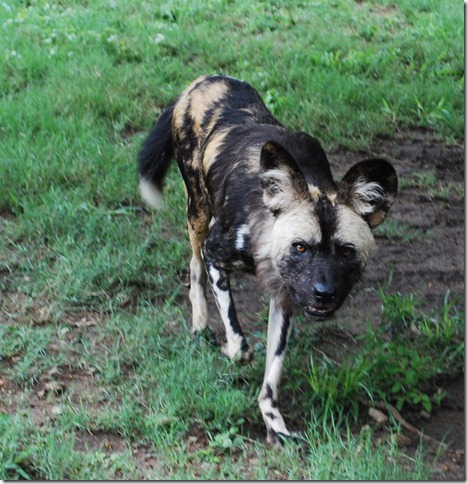 The “devil’s dogs” aren’t the most popular animals in South Africa
The “devil’s dogs” aren’t the most popular animals in South Africa
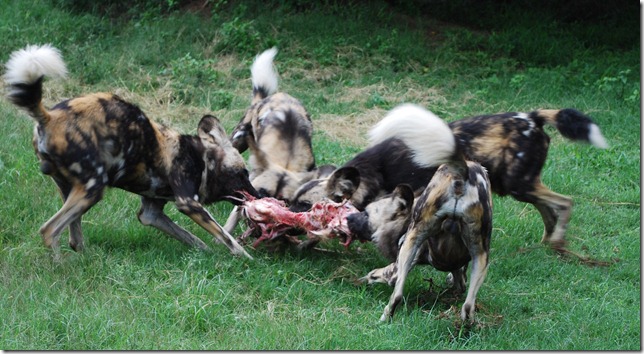 Wild dog table manners don’t take long to learn
Wild dog table manners don’t take long to learn
The most vicious animal in Africa, however, is only a fraction of the size of a wild dog. The honey badger is often bad-tempered and attacks the groin, a technique that has allowed it to kill animals as large as a mature male water buffalo. It’s the only animal that will attack a lion. One of the two honey badgers on site, nicknamed Houdini, once escaped three consecutive times from his enclosure to attack a male lion who was noisy at night. Round 1 went to Houdini, with the lion cowering on top of his shelter when the staff arrived. Round 2 went to the lion the next night, and Houdini was injured pretty badly by time the staff arrived. After stitches and recuperation, Houdini escaped again to attack the lion and this time the staff was able to intervene before things got serious. His escape tricks have been as ingenious as rolling mud in his enclosure into balls and then piling them against the wall until he can climb out and using a newly introduced female honey badger’s back and head as a ladder. He was initially friendly enough to wander among the visitors, but after many “escape wars” that were ended by a wall-top electric fence just like the ones around many urban houses, he’s now has a real dislike for the staff.
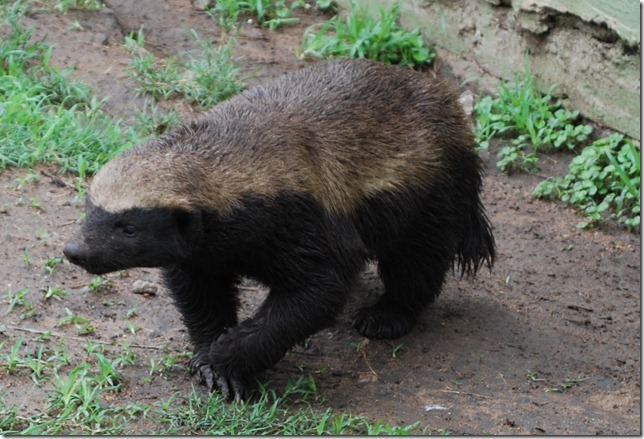 Houdini’s cuddly appearance hides a clever and fearless mind
Houdini’s cuddly appearance hides a clever and fearless mind
We have to say many thanks to Ira, whom I used to work with in California, for introducing us to Brian and Monica from afar and making such a big impact on our stay here. They felt like family by the end of week. Brian and Monica have in turn given us names and numbers for several people along the coast of South Africa that I’m sure will continue to make our experience here a warm and memorable one.
We flew back to Durban today on Mango, one of South Africa’s several discount airlines. By sunset we’d had another visit from Clyde, who’s helping us out with some sail and canvas work and brought over the first of our two trampolines to show us. They’re made from UV-resistant seat belt material and look like they’ll be a big improvement over the death trap we have at the moment. With instructions from the rigger, I was also able to disconnect the forestay and remove the base of the roller furling unit so that we can have new bearings installed.
We learned this week that our South African friends Dave and Shauna of S/V Dragon who had emigrated to New Zealand will be returning to Durban on the 16th, so our departure date is still TBD. For now, there’s plenty of boat work to keep us occupied, and we still haven’t gone a day here in Durban without making a new friend.
What an amazing weekend we’ve had! Brian and Monica have been amazing ambassadors to South Africa. While we are ever so grateful and indebted to them, we’re pretty sure that they’ve had as much fun as we’ve had!
We arrived at Kruger National Park on Friday afternoon. We were immediately besieged by sightings of wild animals near to the car that caused my jaw to drop. Seeing animals in the wild is a completely unique experience, and Kruger is the place to do it. Although there’s a fence around it in order to keep the animals from entering neighboring communities (this is more or less effective), the area inside the fence occupies about 8 million acres! The wild animals within this vast expanse of various terrains include the Big 5: elephants, rhinoceros, leopards, lions, and buffalo, along with thousands of other bird and animal species. All of these roam freely and occupy their place in nature’s food chain with relatively little interference from us humans. Given the fairly high risk of encountering animals that could and would make short work of a human being, humans are required to remain in their vehicles at all times in the park unless otherwise indicated and face a 1500 Rand (over $200) fine if caught taking photos out of the car. Fortunately for us, there is an abundance of animals in the park, and many of them cross public roads or hang out quite near them, thus placing themselves in prime position for observation from us voyeurs.
Just to give you an idea of the frequency with which we sighted something interesting while in the park, here is a sample of my notes from our first afternoon in the park:
1:27 squad of bachelor impala with oxpecker bird eating out of ear
1:32 female and male waterbuck
1:37 vervet monkeys hanging at camp we drove through
1:37 hornbill bird
1:39 guinea fowl in road
1:44 herd of waterbuck crossing road
1:52 2 young elephants!
1:56 herd of buffalo in distance
2:02 HUGE (200) herd of buffalo gathering at water hole with big line of them advancing to join
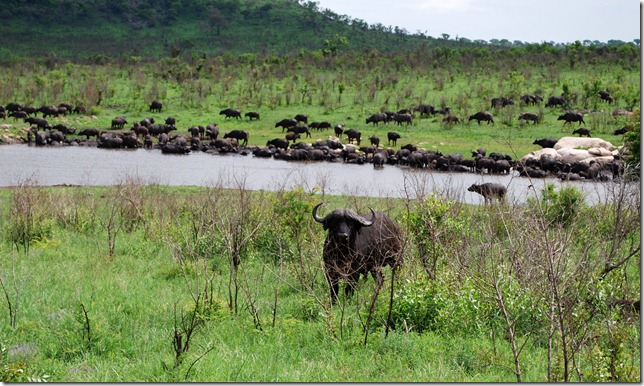
One of the larger water buffalo crossed the pond and checked us out before moving on in search of food
2:02 3 elephants near water hole
2:07 sakubula bird with long tail
2:07 2 hippos in water hole
2:15 3 large elephant and waterbuck near waterhole but staying away because outnumbered by buffalo
2:27 buzzard
Not bad for our first hour, hey? (The ‘hey’ at the end of the sentence is very South African and much like the Kiwis use of ‘ay’). Our sightings got better and better as the weekend progressed. It turns out that Dallas has the eyes of a vulture and can pick out a rhinoceros, for example, from a mile away. The combination of his eyes and the Houghs’ knowledge of the park led us to see all of the Big 5 in one morning! Included in our personal top 5 list were some spectacular sightings that we can’t possibly forget. One of these was a leopard lounging in a tree with his kill (an impala) lying on the ground below, with at least 20 vultures waiting in a tree nearby for their chance at the carcass. We also saw three lions (2 male, one female) a mere 50 yards from the road hanging out under a tree with their zebra kill from the night before (presumably). Another one of Dallas’ favorite sightings was a lone hyena that crossed our path and then rolled around in the dirt on the other side, seemingly to scratch an itch. My personal favorites were also animals that had a lot of personality such as the majestic but cautious elephants, the nervous zebra, and of course, the baboons, who carried on with their tasks of cleaning each other or searching for termites with very, very little regard for passing cars and camera flashes.
In cases like these, a picture really is worth a thousand words, so check these out:
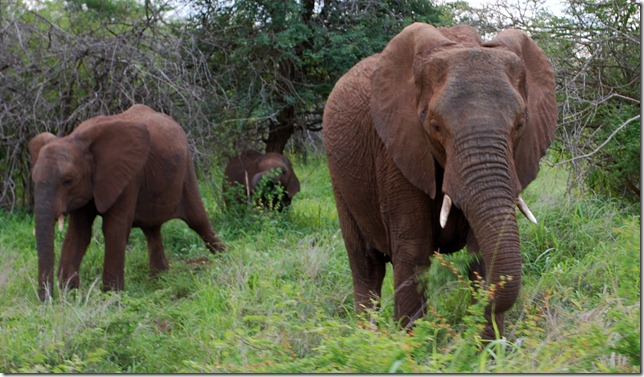 At first seeing elephants up close was thrilling, but by the end of the day on Saturday, we’d seen at least 200!
At first seeing elephants up close was thrilling, but by the end of the day on Saturday, we’d seen at least 200!
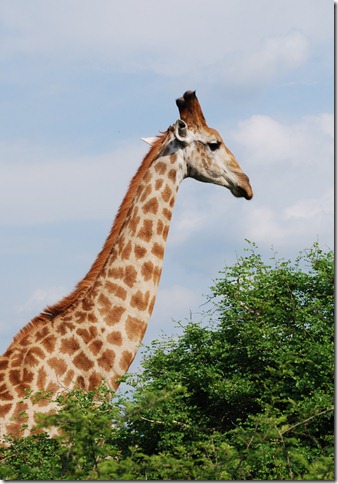 Giraffes were easy to spot and were surprisingly varied in color
Giraffes were easy to spot and were surprisingly varied in color
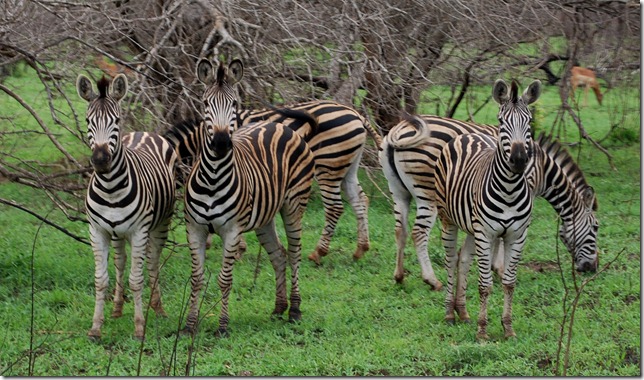 The zebras were the most wary of all animals, probably because they’re so easily spotted by predators
The zebras were the most wary of all animals, probably because they’re so easily spotted by predators
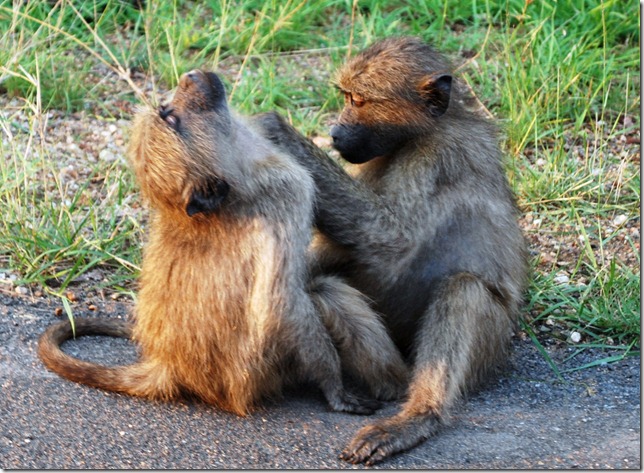 The baboons are very social creatures – where there’s one, there’s a troop nearby
The baboons are very social creatures – where there’s one, there’s a troop nearby
That’s all for now. I need to get some sleep — these South Africans can be hard to keep up with! We’ll post more photos of our sightings, accommodation, and the scenery along with a more detailed account of our time at Kruger and at the Maholoholo Rehabilitation Center as soon as we have a chance. Tomorrow we are going to see some of the sights of Jo’burg before returning to Durban (and Pura Vida) on Wednesday.
Tuesday was another eventful day for us. In the morning I met again with the a local sail/canvas company owner who is going to be making some new trampolines for us. The old ones are getting to the point of being unsafe and prices are good here, so we’re taking advantage of the opportunity. It looks like we may also have some additional canvas-type work done here, which should have the boat looking a little better once we get back to the states. We have a pretty good sewing machine, but it takes a lot of effort and patience for amateurs like us to pull off a major project like a mainsail cover. In the afternoon we had the rigging inspected (I was a little concerned after the broken toggle incident in the Indian Ocean) and got a clean bill of health, which was a bit of a relief. Unfortunately, the lower roller furling bearings, which we’d replaced in New Zealand, rusted out not long after leaving New Zealand and we now need to replace them again. I’m hoping that it won’t be too bad, but dealing with the forestay and furler is never easy.
After so long at sea with almost no social interaction, we’ve wandered into Durban, where we can hardly walk down the dock without meeting someone. We struck up a conversation with a fellow cruising couple coming in by dinghy to get fuel, and after 5 minutes realized that we’d not only had similar experiences as far back as the Marquesas, but after exchanging names, we realized that Lauren and I had read a portion of their blogs fairly closely. They had covered essentially the same route to South Africa via northern Madagascar and Mayotte last year, so I had downloaded their blogs in New Zealand to help plan our route and to read on the Indian Ocean crossing.
Dinner was “Bunny Chow”, a Durban specialty that consists of a hollowed-out loaf of bread filled with a curry that is a must for anyone visiting Durban. Many Indians, including the famous Gandhi, came to South Africa as indentured servants to work the cane fields of Natal province, and Indian culture (both Hindu and Muslim) and food are prevalent here. In the evening we had drinks with another incredibly friendly South African named Dudley at the Point Yacht Club. We’d chatted with him earlier on the docks after noticing his catamaran, and we had a chance to get to know him better that evening. He and his wife had purchased a catamaran with plans to spend a portion of their retirement cruising, but after passages filled with horrible seasickness and a nasty bout of dysentery in Mozambique, he’s decided the sailing life isn’t for him and has put the boat up for sale while contemplating his next move. He’s an airplane mechanic and pilot who has spent a fair amount of time flying for the UN and Red Cross in places like Pakistan/Afghanistan (back when the CIA was working with the Taliban), Congo, Sudan, etc. His stories were something else, and we enjoyed talking over a range of topics. When we finally left the club, it was off to make a late appearance at a Christmas party on one of the ARC boats that finally wrapped up for us well after midnight. So much for taking it easy on land.
We were up early on Wednesday to pack. We’d decided to take Brian and Monica up on their offer to come home with them to Johannesburg and then on to Kruger Park for game watching this weekend. Needless to say, we were pretty excited at the chance to see more of the country, get a local introduction to Johannesburg, and go game watching in South Africa’s largest game park. Their hospitality has really been incredible. I’m half Brian’s age, but his energy level has me feeling like it’s the other way around. The drive back to Jo’burg, as it’s called, gave us a chance to see the valley of a thousand hills in Natal, the Drakensberg mountains in the distance, the expansive plateau plains of the Free State, and of course Jo’burg in Gauteng Province. I have to say that the two biggest impressions I had were how beautiful parts of the drive were and how “first-world” the vast majority of sights were. There are exceptions of course, like the slums of shacks at the city’s edge, the small, rough wooden shacks of Zimbabwean immigrant laborers across the highway from a wood processing plant, crowded but clean and orderly government-funded low income housing developments with houses less than half the size of the smallest houses in the US, and the ubiquitous parking lot “car-watchers” working for tips. None of the drive passed through the former “homeland” areas (sort of like US Indian reservations), where under apartheid blacks were forced to live and pursue at least quasi independence in the hopes that whites could one day keep the non-homeland areas as a separate, white South Africa. I was guessing that those areas wouldn’t appear as well developed, but most of what we saw was remarkably similar to a cross-country drive in the US, complete with fast-food complexes beside major gas stations.
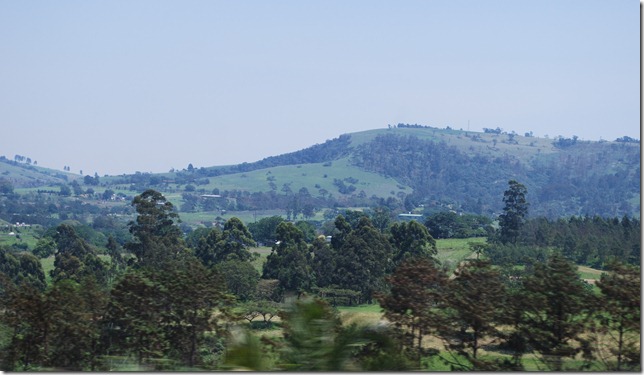 The valley of a thousand hills was filled with scenes like this one
The valley of a thousand hills was filled with scenes like this one
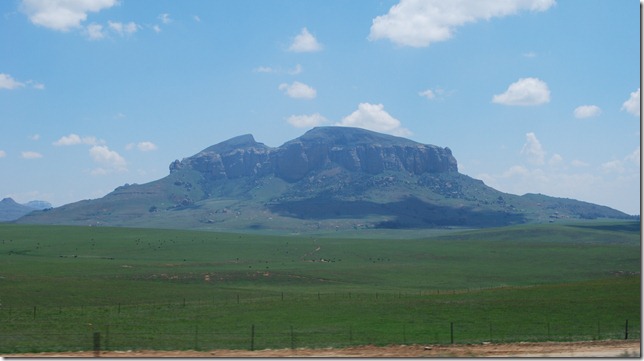 The vistas in the Free State featured large areas of farm and grazing land surrounded by distant hills and mountains
The vistas in the Free State featured large areas of farm and grazing land surrounded by distant hills and mountains
We’re leaving for Kruger Park early tomorrow, but in the short time we’ve been here we’ve managed to fit in some wonderful meals, a chance to watch the Hough’s talented granddaughter sing at a local restaurant, a shopping trip for road trip provisions, a ride in Brian’s 1942 Harley Davidson with sidecar, website and email catch-up, and a sample or two from the well-stocked wine cellar.
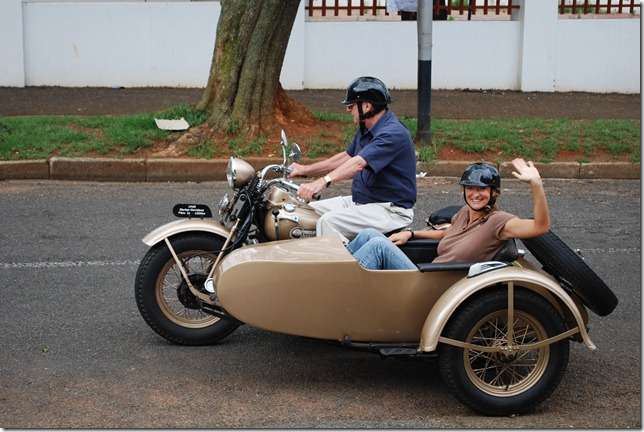 We may have to consider travelling like this when we get back to the states
We may have to consider travelling like this when we get back to the states
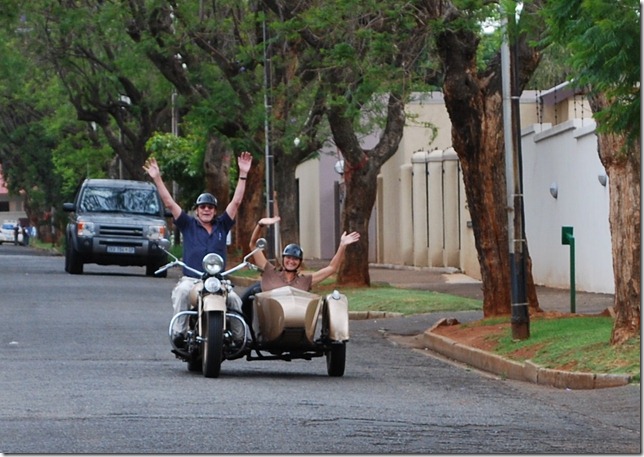 We’re not kidding when we say we’ve been having fun
We’re not kidding when we say we’ve been having fun
South Africa’s present and future are so tied to both its own history and the history of its neighbors that one can seemingly have a good conversation with almost anyone about past, present, and future. Race is also anything but the elephant in the room. Being so integral to the South African milieu, race is something that’s often discussed and joked about openly not only in white-only or black-only settings, but in mixed settings and between blacks and whites. At first it’s all a bit overwhelming in how different it is from anything we’ve experienced before, but before long, you begin to see that people grow accustomed to it. Crime is always a topic, but people get used to the risk and impacts on their daily lives. The “growing pains” that are very much a part of a new country, especially an African one, have been cause for some to leave South Africa, but seem to be taken in stride by many of those that have not.
This evening we had a chance to meet the black deputy editor of a local newspaper who came over to say hello and have a drink before heading back to the office (it’s been a while since I’ve headed back to the office after dinner). After discussing a local fraud, corruption, and murder case that included the Chief of Police but resulted in far fewer convictions than it should have, he shook his head and said, “Yes, but life goes on.” It’s a phrase I’ve heard a lot, but I don’t think I’ve ever heard it said quite that way, by someone who realizes how disappointing and indicative an event is, has seen it many times before, but still retains a belief that things are moving forward. He’s obviously a very intelligent and well-informed individual, and it was nice to see his optimism, even if it was measured. In yesterday’s paper there’s an article about how a government audit found that the head of the social equality department had used a pretty sizeable amount of government funds for personal use. Significant press freedoms were written into the new constitution and the press has uncovered a fair amount of corruption and incompetence, delivering scathing articles that now have the government pushing for laws giving it the ability to restrict the press. It’s a strange turn-about that local political cartoonists are having a field day with, and it’s being vigorously opposed. We’re certainly still in the process of forming our own opinions about South Africa, but I can definitely say that boring and dull are out of the running.


